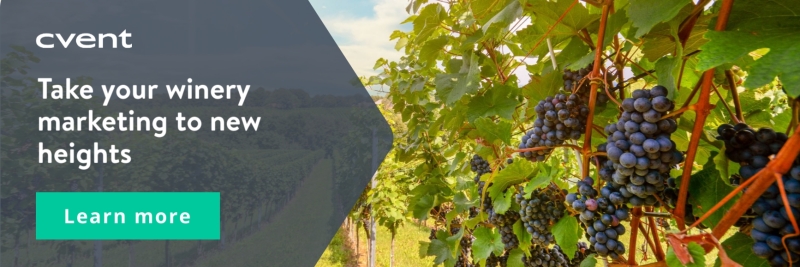Whether you operate a small, family-owned winery in a rural area or a massive property located in the heart of wine country, every location can benefit from a marketing refresh. That's where this winery marketing guide comes in.
In this post, we jump right in and discuss a variety of winery marketing tips and strategies you can use to reach more customers, drive more business, outshine your comp set, increase revenue, and much more.
Explore 11 winery marketing tips and strategies that actually work
1. Market your winery as an event venue.
Move beyond marketing your property as a winery alone; market it as an event venue on the Cvent Supplier Network and as a wedding venue on Wedding Spot.
- Cvent Supplier Network: Thousands of planners source their meetings through the Cvent Supplier Network. With CSN Advertising, you can put your message in front of them as they decide which destinations, venues, and event services will receive their RFP.
- Wedding Spot: Fill need dates and drive weekend revenue by marketing to thousands of couples on Wedding Spot — a platform designed to give couples the tools to successfully find the right venue and give suppliers the opportunity to drive more wedding business.
2. Tell your story.
It's a high-level tip, but it's one that's overlooked far too often: Storytelling. When a potential customer sees an ad for your winery, whether online or in print, do they immediately get an idea of your brand and who you are? If not, should they?
Understand what sets your business apart from competing wineries as well as what you do better than anyone else. Ask yourself the following questions:
- Are you in a unique location?
- Does your architecture stand out?
- Does the winery have any historical significance?
- Does the business have a rich family history?
- What do you want customers to see, hear, and feel when they think of your business?
If you have any unique selling points, make it a priority to connect with your customers in a personal and memorable way; customers perceive storytelling in marketing as 22 times more memorable than fact-based advertising. Use your winery marketing as a platform to tell the story of your business and the team that keeps it going.
3. Get to know your audience.
In order to successfully appeal to your customers, it’s important to understand who they are. Identify what they like, how the behave, and how they see your business.
- What are the demographics of your customer base?
- How/where are customers finding your business?
- What are your most popular offerings or services, and why?
- What are the most common concerns or complaints customers make?
- Are you primarily seen a winery only, as a winery and restaurant, or as an entire event venue?
- Do people contact the winery for weddings, wedding parties, bachelor and bachelorette parties, birthday parties, or other social events?
Take what you know about your customers and use it to create targeted, personalized winery marketing campaigns.
4. Build, and maintain, your online presence.
Build a top-tier website that highlights your winery's key features, services, and rave reviews. If you haven’t already, add social media advertising to your winery marketing to-do list. Instagram, Facebook, and TikTok are great promotional tools for marketing on a budget. They offer a variety of free and paid advertising services, as well as a vast suite of easy-to-use digital marketing tools.
To improve your online presence and widen the reach of your digital marketing, consider the following:
- Post relevant and creative content regularly.
- Ensure that information is accurate across all channels.
- Engage with members of your audience.
- Read and respond to guest reviews.
- Post high-quality photographs.
- Share a variety of content and media types.
- Encourage customers and visitors to post original content on your pages.
5. Start, and market, a wine club.
Increase winery profits and reach new customers by starting a wine club. Offer membership in your wine club for a fee that makes sense for your target audience. Offer rewards, promotional purchase pricing, reduced admission to events, exclusive samples, and other loyalty perks.
Wine clubs provide winery marketers with a way to improve direct-to-consumer (DTC) sales and grow profits while building a business base founded on customer loyalty. With DTC wine sales on the rise, wineries who choose not to offer a club or membership opportunity may be missing out.
Wine Vines Analytics partnered with Sovos to produce a 2022 Direct to Consumer Wine Shipping Report, which found that DTC wine club sales exploded in 2021. In fact, wine club sales outpaced tasting room sales for the very first time, with customers spending over $4 billion in DTC wine purchases. While the report notes that some of the growth was the result of pandemic restrictions and venue closures, it also identifies that the trend has been steadily growing and is likely to continue.
In marketing materials for the wine club, clearly outline the exclusive perks that members will receive, and the benefits of joining. For example, membership may grant customers two bottles of wine a month, free access to limited tastings, winery merchandise, or a 10% off all in-house purchases.
6. Offer free tastings or sample packages.
While it may seem counterintuitive to offer free products in an effort to bring in more money, free tastings are a key component of most winery operations. Even while offering free wine to visiting tasters, wineries can use these events to drive additional revenue and market to new customers.
Thoughtfully plan and promote tasting events. Offer a small, initial tasting of 4-5 wines at no-cost to entice new consumers and draw a crowd. Then, offer additional tastings for a fee. If guests enjoy the initial free tastings provided, they may choose to purchase an additional tasting, a charcuterie board, a branded wine glass, or a bottle to take home. Impress visitors with a knowledgeable staff, beautiful property, and an engaging tasting event led by an enthusiastic wine expert.
7. Engage in cross promotion.
Take advantage of cross-promotion opportunities by partnering with small businesses, local artists, and other artisans in your area. Showcase a variety of local products for sale and ask partners to do the same with yours. Dedicate a portion of your winery to displaying local brochures, newsletters, small advertisements, and other promotional materials.
Provide partnering businesses with winery marketing materials for display. Always offer cross-promotional services in return to grow a reliable network of partners, vendors, and friends. Look for public advertising opportunities well, such as park bulletin boards, in the windows of downtown shops (with permission), and other areas of heavy foot traffic.
8. Create a B2B scavenger hunt.
Partner with a group of related businesses nearby to create a scavenger hunt map that connects your businesses. Offer participants discounts, membership rewards, swag, or free services for completing various activities at each location. Offer impressive prizes for hunters who finish the entire map, visiting each of the businesses and completing all of the challenges. Create a punch card or use a mobile app to track participant progress.
9. Take your winery on tour.
Take your winery on the road to widen your audience base and make fruitful connections. Visit local wine and beer festivals, music festivals, and farmer’s markets. Become a regular vendor!
Create travel-friendly winery marketing materials to give out along the way. Magnets, corkscrews, and collapsible glasses are all small, durable, and easy to lug from place to place. While on tour, network and make business contacts while you grow your business. Sell your products, promote your wine club, and invite excited customers to come pay a visit.
10. Host virtual events.
Advancements in virtual and augmented reality have given winery owners, operators, and marketing managers exciting new opportunities to connect with consumers. We have virtual meeting platforms, video conferencing tools, the metaverse, and other exciting resources that connect us with consumers. Use this technology to host virtual events, bringing your winery to folks at home.
A few examples of virtual winery events include:
- Virtual wine tastings
- Sommelier Q&As
- Step-by-step winemaking tutorials
- “Cooking With Wine” classes
Consider your audience and plan exciting virtual events based on their habits, preferences, and passions.
11. Create and share relevant content.
Personalization is a critical component of successful winery marketing. To appeal to your audience, you need to produce marketing content that they find relevant. Create different winery marketing campaigns for audience sub-groups, as relevant content shifts from group to group. Millennial wine drinkers, for example, may respond to differing winery marketing that Gen Xers do.
Do you produce organic wine? Is that a big part of your mission and why customers like your product? If so, create marketing content for your winery that focuses on the importance of sustainability and organic living. Offer videos, classes, downloadable templates, or other resources related to mission-driven activities like organic gardening and sustainable winemaking.
You’re ready to start a new winery marketing campaign!
Keep track of all winery marketing efforts to track which strategies are the most successful. See what works, what doesn’t, and capitalize on the winery marketing styles that fit your business. Eliminate less successful campaigns and spend your marketing dollars where they count most.
Up next, we take a deep dive into the wedding boom and explore eight ways for your venue to seize the moment.








